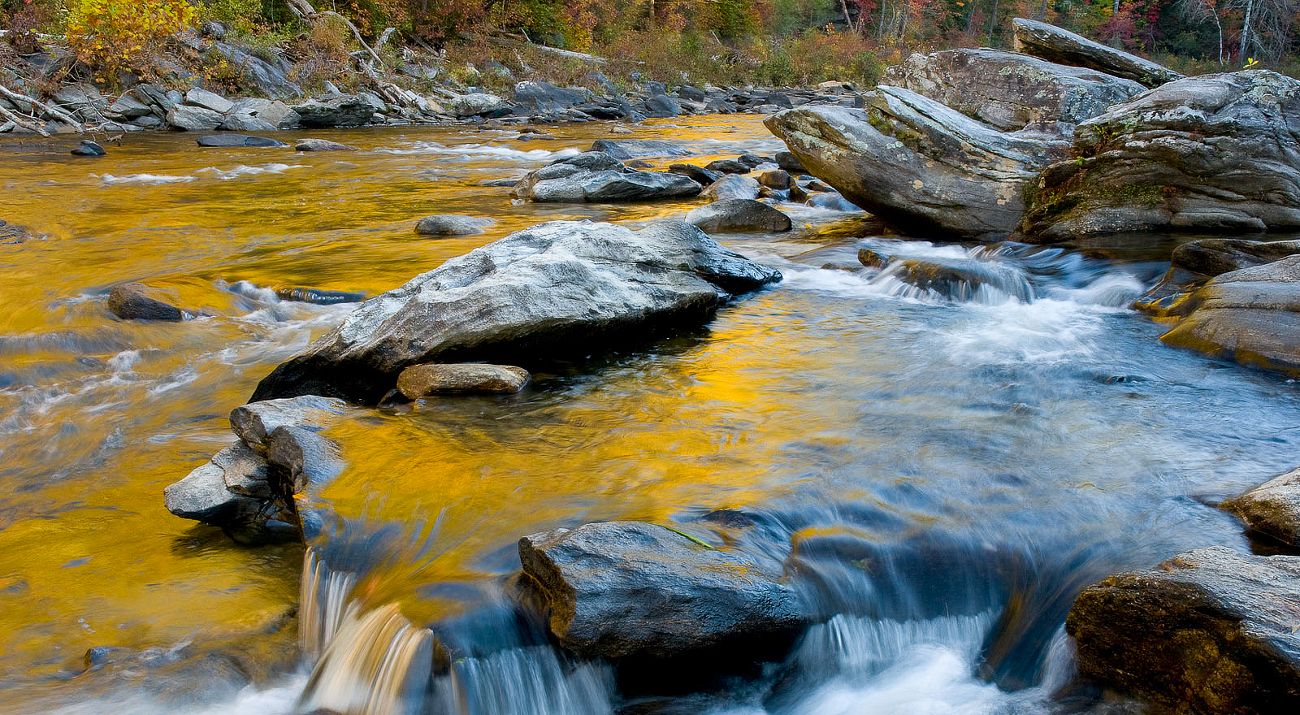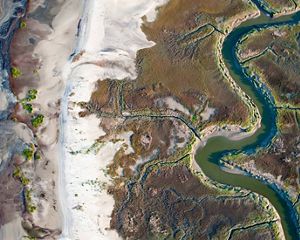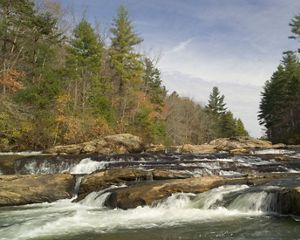Safeguarding Georgia’s Water Future
We’re working on multiple fronts to secure clean water for drinking, recreation, wildlife habitat and more.
The health of Georgia’s creeks, streams and rivers is vitally important to people and nature. Our rivers are home to large, diverse, unique communities of freshwater fish and amphibians—including darters, sunfishes, shiners and more. Communities depend on the availability of clean water for drinking, agriculture and recreation.
TNC is working on multiple fronts to protect Georgia’s fresh water and ensure the availability of clean water for people and nature.
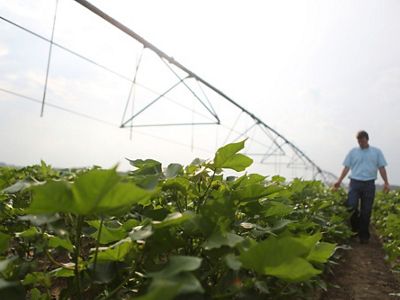
Securing Abundant Water
Agriculture is an important part of Georgia’s economy and heritage. Our agriculture industry also is one of the state’s largest water consumers, but Georgia is a leader in developing and deploying water-saving technology for irrigation systems that other states, regions and nations have adopted.
TNC and partners have worked with farmers in the Lower Flint River Basin to empower them with resources and tools they need to meet the increasing demands of a growing population, while safeguarding their livelihoods and protecting our valuable water resources. TNC’s active engagement in this work wrapped up several years ago, but key allies continue to innovate and engage with farmers.
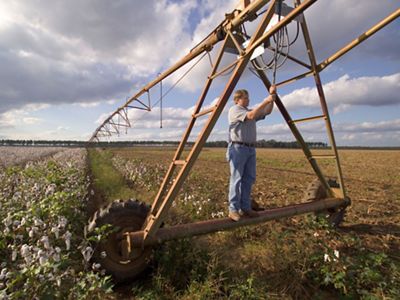
Our evaluation of this work in 2017 revealed near-universal application of basic irrigation efficiency measures—but much work still to be done to ensure enough water stays in Flint River Basin streams, especially during periods of severe drought.
TNC is currently working with experts in the region to develop and test innovative incentive programs to focus and intensify water savings when and where they are needed most. This will help ensure we meet the conservation objective of sustaining the unique aquatic biodiversity found in the Lower Flint River Basin. Learn more about the Georgia Flow Incentive Trust.
Removing Barriers: Helping Fish Get Where They Need to Go
Freshwater fish need to travel rivers and streams freely to reach environments where they eat and reproduce. Dams and culverts at road-stream crossings can cause major roadblocks to fish passage. The blocks fragment habitat and degrade the streams, so species suffer. Additionally, poorly designed and aging infrastructure poses many hazards to the public when they fail. Addressing these issues before a dam or culvert fails can be a win for people AND nature.
TNC helps lead the Georgia Aquatic Connectivity Team, a self-selecting group of people from across the state representing all the State and Federal agencies involved in regulating stream quality and dam safety, hydropower interests, paddling groups, Universities, environmental engineers, other conservation groups, and individuals interested in removing barriers to aquatic connectivity. The group identifies high priority projects to open and improve habitat for aquatic species such as fish, mussels and amphibians while ensuring public safety for people recreating, traveling or living in proximity to dams and stream crossings. The GA-ACT has published two guidebooks to help people in Georgia address barriers:
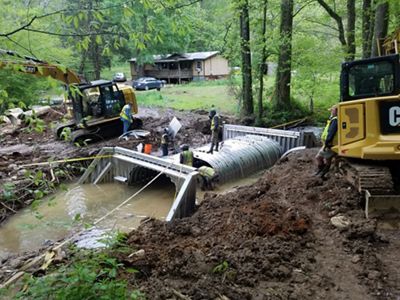
In 2017, TNC proposed a project to remove three high priority dams on land we own near Fort Benning in the Upatoi Creek watershed, a major tributary to the Chattahoochee River. Some of the changes included:
- All three failing dams were to be partially removed and the new stream banks stabilized.
- At Little Pine Knot dam, a new stream channel was constructed, bypassing the original channel route to ensure a more stable slope connecting the up- and down-stream segments.
- Stabilizing structures were constructed in the new stream channels following Natural Channel Design principles.
- The riparian areas were revegetated with native grasses and shrub stakes.
- An undersized culvert downstream of Little Pine Knot dam was replaced with a low-water crossing.
Columbus State University faculty and students began monitoring the construction sites and several reference sites in 2019 and will continue to monitor the impacts of the dam removal and stream restoration through summer 2021, and this work will form the basis of at least one Masters’ Thesis. This work has already documented movement of fish and crayfish in the newly restored channels.
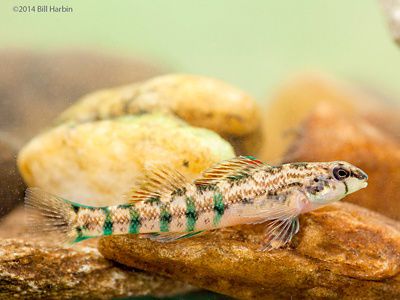
The Raccoon Creek Watershed, which runs through the 25,707-acre Paulding Forest Wildlife Management Area, has long been a high priority for aquatic habitat restoration. It provides the only known habitat for the federally endangered Etowah darter downstream of Lake Allatoona and it supports the largest known community of an isolated sub-population of the federally threatened Cherokee darter. Forty-three other native fishes also are found in the Raccoon Creek aquatic community.
In order to improve the overall habitat in the Raccoon Creek watershed, TNC partners with the Coosa River Basin Initiative, Georgia Department of Natural Resources, Kennesaw State University (KSU), Paulding County and the U.S. Fish and Wildlife Service. With these partners, we identify and prioritize sites to protect and restore. We also educate local landowners on how their properties and land-management practices impact the watershed.
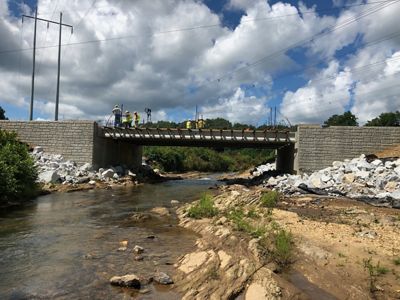
In the early 2000s, the removal of a multi-box culvert at Racoon Creek Road became a priority goal. In 2019, the culvert was removed and replaced with a free-span bridge. KSU graduate student Will Commins has monitored fish populations throughout the project to document the movement of fish above and below the culvert prior to its removal and will continue to monitor fish movement under the bridge to quantify the project’s impact on fish passage.
“Our ongoing habitat restoration work in the Raccoon Creek Watershed is the result of applying science and creative collaborations to meet conservation goals. Each partner played a key role in making this project a reality,” Katie Owens, Coosa River Basin Program Director.
Restoring Wetlands to Improve Water Quality
Home to more than 75 species of freshwater fish—including federally endangered or threatened species—the Conasauga River is among the most biodiverse rivers in the United States. An unparalleled number of mussels, snails, salamanders and crayfish also inhabit the Conasauga’s waters.
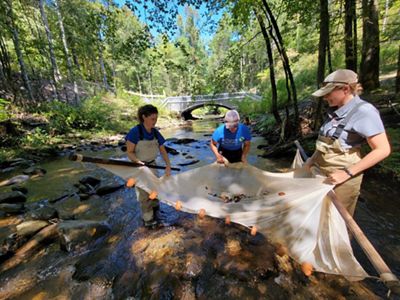
Georgia’s watersheds have experienced major transformation over the last century: landuse conversion, dam construction, expanding of cities, channelization of rivers and streams. But the extraordinary biodiversity of our watersheds endures.
Our freshwater wetlands work focuses on sound science and effective collaboration with state and federal agencies, conservation organizations and landowners. TNC is working with north Georgia landowners to implement a USDA Natural Resources Conservation Service Regional Conservation Partnership Program grant to protect and restore stream buffers and wetland habitat, thus reducing nutrient and toxin loading in this high-risk watershed.
